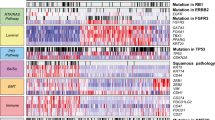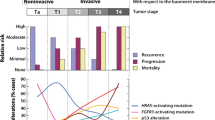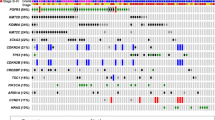Abstract
Bladder cancer is the fourth most common cancer in men and fifth most common overall. The use of next-generation sequencing (NGS) approaches is crucial to precisely characterize the molecular defects of tumors, and this information could be combined with other clinical data, such as tumor histology and TNM staging, with the goal of precise tumor classification. In many settings, targeted NGS is evaluated in patients with first- and second-line metastatic cancer. Yet, in the decade to come we anticipate increased application of precision oncology at all stages of bladder cancer with the aim of customizing cancer treatment. Here, we review the genomic and transcriptomic features associated with risk stratification in bladder cancer and summarize the current efforts for precision oncology in localized urothelial carcinomas.


Similar content being viewed by others
References
Howlader NNA, Krapcho M, Garshell J, Miller D, Altekruse SF, Kosary CL, Yu M, Ruhl J, Tatalovich Z, Mariotto A, Lewis DR, Chen HS, Feuer EJ, Cronin KA. SEER Cancer Statistics Review, National Cancer Institute. Bethesda, MD
Chang SS, Boorjian SA, Chou R et al (2016) Diagnosis and treatment of non-muscle invasive bladder cancer: AUA/SUO guideline. J Urol 196:1021–1029
Clark PE, Spiess PE, Agarwal N et al (2016) NCCN guidelines insights: bladder cancer, Version 2.2016. J Natl Compr Canc Netw 14:1213–1224
Glaser AP, Fantini D, Shilatifard A et al (2017) The evolving genomic landscape of urothelial carcinoma. Nat Rev Urol 14:215–229
Babjuk M, Bohle A, Burger M et al (2017) EAU guidelines on non-muscle-invasive urothelial carcinoma of the bladder: update 2016. Eur Urol 71:447–461
Kirkali Z, Chan T, Manoharan M et al (2005) Bladder cancer: epidemiology, staging and grading, and diagnosis. Urology 66:4–34
Sylvester RJ, van der Meijden AP, Oosterlinck W et al (2006) Predicting recurrence and progression in individual patients with stage Ta T1 bladder cancer using EORTC risk tables: a combined analysis of 2596 patients from seven EORTC trials. Eur Urol 49:466–477 (discussion 475–467)
Hurst CD, Alder O, Platt FM et al (2017) Genomic subtypes of non-invasive bladder cancer with distinct metabolic profile and female gender bias in KDM6A mutation frequency. Cancer Cell 32:701–715.e707
Meeks JJ, Lerner SP (2017) Molecular landscape of non-muscle invasive bladder cancer. Cancer Cell 32:550–551
Pal SK, Rosenberg JE, Hoffman-Censits JH et al (2018) Efficacy of BGJ398, a fibroblast growth factor receptor 1–3 inhibitor, in patients with previously treated advanced urothelial carcinoma with FGFR3 alterations. Cancer Discov 8:812–821
Hahn NM, Bivalacqua TJ, Ross AE et al (2016) A phase II trial of dovitinib in BCG-unresponsive urothelial carcinoma with FGFR3 mutations or overexpression: Hoosier Cancer Research Network Trial HCRN 12-157. Clin Cancer Res 23(12):3003–3011
Hedegaard J, Lamy P, Nordentoft I et al (2016) Comprehensive transcriptional analysis of early-stage urothelial carcinoma. Cancer Cell 30:27–42
Sjodahl G, Lauss M, Lovgren K et al (2012) A molecular taxonomy for urothelial carcinoma. Clin Cancer Res 18:3377–3386
Meeks JJ, Carneiro BA, Pai SG et al (2016) Genomic characterization of high-risk non-muscle invasive bladder cancer. Oncotarget 7(46):75176
Patschan O, Sjodahl G, Chebil G et al (2015) A molecular pathologic framework for risk stratification of stage T1 urothelial carcinoma. Eur Urol 68:824–832 (discussion 835–826)
Kim YJ, Ha YS, Kim SK et al (2010) Gene signatures for the prediction of response to Bacillus Calmette-Guerin immunotherapy in primary pT1 bladder cancers. Clin Cancer Res 16:2131–2137
Warrick JI, Hovelson DH, Amin A et al (2015) Tumor evolution and progression in multifocal and paired non-invasive/invasive urothelial carcinoma. Virchows Arch 466:297–311
Riaz N, Havel JJ, Makarov V et al (2017) Tumor and microenvironment evolution during immunotherapy with nivolumab. Cell 171(934–949):e915
Robertson AG, Kim J, Al-Ahmadie H et al (2017) Comprehensive molecular characterization of muscle-invasive bladder cancer. Cell 171(3):540–556
Cancer Genome Atlas Research N (2014) Comprehensive molecular characterization of urothelial bladder carcinoma. Nature 507:315–322
Alexandrov LB, Nik-Zainal S, Wedge DC et al (2013) Signatures of mutational processes in human cancer. Nature 500:415–421
mutSignatures: Decipher Mutational Signatures from Somatic Mutational Catalogs
Fantini D, Seiler R, Meeks JJ (2018) Molecular footprints of muscle-invasive bladder cancer in smoking and non-smoking patients. Urol Oncol
Glaser AP, Fantini D, Rimar KJ et al (2017) APOBEC-Mediated Mutagenesis In Urothelial Carcinoma Is Associated With Improved Survival, Mutations In DNA Damage Response Genes, And Immune Response. bioRxiv
Fantini D, Glaser AP, Rimar KJ et al (2018) A Carcinogen-induced mouse model recapitulates the molecular alterations of human muscle invasive bladder cancer. Oncogene 37:1911–1925
Wang L, Zhao Z, Ozark PA et al (2018) Resetting the epigenetic balance of Polycomb and COMPASS function at enhancers for cancer therapy. Nat Med 24:758–769
Rimar KJ, Tran PT, Matulewicz RS et al (2017) The emerging role of homologous recombination repair and PARP inhibitors in genitourinary malignancies. Cancer 123:1912–1924
Van Allen EM, Mouw KW, Kim P et al (2014) Somatic ERCC2 mutations correlate with cisplatin sensitivity in muscle-invasive urothelial carcinoma. Cancer Discov 4:1140–1153
Plimack ER, Dunbrack RL, Brennan TA et al (2015) Defects in DNA repair genes predict response to neoadjuvant cisplatin-based chemotherapy in muscle-invasive bladder cancer. Eur Urol 68:959–967
Liu D, Plimack ER, Hoffman-Censits J et al (2016) Clinical validation of chemotherapy response biomarker ERCC2 in muscle-invasive urothelial bladder carcinoma. JAMA Oncol 2:1094–1096
Felsenstein KM, Theodorescu D (2018) Precision medicine for urothelial bladder cancer: update on tumour genomics and immunotherapy. Nat Rev Urol 15:92–111
Teo MY, Seier K, Ostrovnaya I et al (2018) Alterations in DNA damage response and repair genes as potential marker of clinical benefit from PD-1/PD-l1 blockade in advanced urothelial cancers. J Clin Oncol 36:1685–1694
Damrauer JS, Hoadley KA, Chism DD et al (2014) Intrinsic subtypes of high-grade bladder cancer reflect the hallmarks of breast cancer biology. Proc Natl Acad Sci USA 111:3110–3115
Kardos J, Chai S, Mose LE et al (2016) Claudin-low bladder tumors are immune infiltrated and actively immune suppressed. JCI Insight 1:e85902
Sjodahl G, Eriksson P, Lovgren K et al (2018) Discordant molecular subtype classification in the basal-squamous subtype of bladder tumors and matched lymph-node metastases. Modern Pathol
Sjodahl G, Eriksson P, Liedberg F et al (2017) Molecular classification of urothelial carcinoma: global mRNA classification versus tumour-cell phenotype classification. J Pathol 242:113–125
Marzouka NA, Eriksson P, Rovira C et al (2018) A validation and extended description of the Lund taxonomy for urothelial carcinoma using the TCGA cohort. Sci Rep 8:3737
Mariathasan S, Turley SJ, Nickles D et al (2018) TGFbeta attenuates tumour response to PD-L1 blockade by contributing to exclusion of T cells. Nature 554:544–548
Seiler R, Ashab HAD, Erho N et al (2017) Impact of molecular subtypes in muscle-invasive bladder cancer on predicting response and survival after neoadjuvant chemotherapy. Eur Urol 72:544–554
Funding
JJM is supported by Grant BX003692 and the John P. Hanson Foundation for Cancer Research at the Robert H. Lurie Comprehensive Cancer Center of Northwestern University.
Author information
Authors and Affiliations
Contributions
Fantini- data collection and management, manuscript writing/editing. Meeks- data collection and management, manuscript writing/editing
Corresponding author
Ethics declarations
Ethical statements
All research involving human subjects should refer back to primary studies.
Conflicts of interest
JJM is a consultant for AstraZeneca and Ferring and receives research funding from Epizyme, NextCure, Abbvie and Tesaro.
Rights and permissions
About this article
Cite this article
Fantini, D., Meeks, J.J. Genomic classification and risk stratification of bladder cancer. World J Urol 37, 1751–1757 (2019). https://doi.org/10.1007/s00345-018-2558-2
Received:
Accepted:
Published:
Issue Date:
DOI: https://doi.org/10.1007/s00345-018-2558-2




